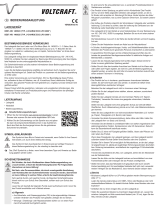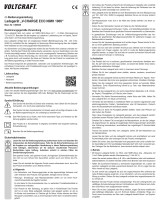
• Do not leave the batteries connected to the charger when the charger is not
needed.
Disconnect the charging set from the mains voltage. Pull the mains plug out of the
mains socket. Afterwards, keep the product in a clean, dry, and out of children's
reach place.
• Only use the device in a moderate climate, do not use it in a tropical climate.
For more information on acceptable environmental conditions, see the chapter
"Technical Data".
• Never use the product immediately after it has been brought from a cold room
into a warm one. The resulting condensation may lead to malfunctions or damage
under certain circumstances! Furthermore, this could cause a lethal electric shock!
Allow the charger (and the battery/batteries) to reach room temperature before
connecting the charger to the power supply and using it. This may take several
hours!
• Please handle the product carefully. The product can be damaged if crushed,
struck, dropped even from a low height or subjected to mechanical pressure and
vibrations.
• If it can be assumed that safe operation is no longer possible, the product must
be turned off and precautions are to be taken to ensure that it is not used unin-
tentionally.
It can be assumed that safe operation is no longer possible if the product is visibly
damaged, the product does not work at all, if it was stored long-term in unfavoura-
ble conditions, or if it was exposed to heavy loads during the transport.
d) Handling Rechargeable Batteries
• Keep rechargeable batteries out of the reach of children. Always keep rechargea-
ble batteries out of the reach of children.
• Do not leave accumulators lying around openly. Children or pets may swallow
them. In such a case, call a doctor immediately!
• Accumulatorsmustneverbeshort-circuited,takenapartorthrownintore.There
isariskofreandexplosion!
• If your skin comes into contact with leaking or damaged batteries, you may suffer
burns. Thus you should use suitable protective gloves.
• If any battery connector cables need to be cut to size (e.g. if the battery is supplied
without a connector plug), cut each cable individually to prevent a short circuit
occurring.Riskofreandexplosion!
• Only use the charger to charge the batteries with the suitable battery technology
(NiCd or NiMH). Never use this device to charge other types of rechargeable bat-
teriesornon-rechargeablebatteries.Thereisariskofreandexplosion!
Non-rechargeable batteries are meant to be used once only and must be disposed
of when empty. Charge rechargeable batteries intended for that use only.
• Batteries must not get damp or wet.
• Neverdamagetheexteriorofabattery.Thereisariskofreandexplosion!
• Never charge/discharge rechargeable batteries unattended.
• Never charge/discharge a battery directly in the model. First, remove the battery
fromthemodel;separateitcompletelyfromthespeedcontrollerorautopilot.
• Please observe the correct polarity (plus/+ and minus/-) when inserting the rechar-
geable battery into the charger or into the model (for e.g. an autopilot). Should you
connect the battery incorrectly, not only will the model be damaged but also the
battery.Thereisariskofreandexplosion!
• Do not charge any battery that is still hot (e.g. caused by high charge current from
the model). Allow the battery to cool down to room temperature before attempting
to charge it again.
• Never charge/discharge damaged, leaking or deformed batteries. This can result
inareorexplosion!Disposesuchunusablebatteriesinanenvironmentallycom-
patible manner.
• Never use battery packs that are composed of different types of cells.
• Recharge the accumulators about every 3 months, as otherwise there may be
a total discharge due to self-discharge, which makes the accumulators useless.
• Disconnect the battery from the charger when the battery is fully charged.
• Improper use (too high charging current or incorrect polarity) can supercharge or
damage the rechargeable battery. In the worst case, the rechargeable battery can
explode and thereby cause serious damage.
• Never damage the battery, never let the battery fall, do not pierce the battery with
any objects! Avoid applying any mechanical loads to the battery, never pull on the
battery'sconnectorcables!Thereisariskofreandexplosion!
These guidelines must also be observed when the battery is inserted into the
model (if the model is removed, for example).
• Ensure that the battery does not overheat during usage, recharging, discharging,
transport or storage. Do not place the battery adjacent to sources of heat (e.g.
cruise control, motor), keep the battery away from direct sunlight. There is a risk of
reandexplosionifthebatteryoverheats!
• The battery must not reach a temperature higher than + 60 °C (observe additional
instructions of the manufacturer with other limitations as applicable!).
• If there are damages on the battery, do not use it any more. Do not recharge it.
Thereisariskofreandexplosion!
Only touch the battery with care, use suitable protective gloves.
Dispose of the battery in an environmentally compatible manner.
• When there is no information available from the battery manufacturer about the
maximum permitted charging current, charge the NiCd/NiMH battery with a char-
ging current of max. 1C. This means that the charging current may not exceed
the capacity value imprinted on the battery (e.g. battery capacity 1000 mAh, max.
charging current 1000 mA = 1 A).
• Observe the additional safety instructions from the manufacturer of the batteries/
battery packs that you use.
Connections and Control Elements
1 Mains supply socket
2 Plug of the charging cable
3 Power LED
4 Status LED
Installation and Operation
• Connect the power socket (1) to an appropriate mains socket via the supplied power cable.
The Power LED (3) lights up green when the charger is ready for operation.
• Placethechargeronalevel,at,stablesurface.Protectvaluablefurnituresurfacesbyusing
a suitable mat to prevent scratches, pressure points or discolourations.
• The casing of the charger heats up during operation. Make sure that the charger is always
adequatelyventilated;nevercoveritwhileinoperation.
• Connect the battery that you want to charge with the plug (2) of the charger. Observe the
correct polarity (plus/+ = red cable, minus/- = black cable).
• The charging process starts immediately after the battery is connected.
• A LED status indicator (4) indicates the function of the charger:
LEDisoff: Nobatteryidentied
LED lights up red: The charging process is under way
LEDlightsupgreen: Thechargingprocessisnished
LEDashesred: Anerrorisindicated(fore.g.wrongpolarityforthebattery,battery
deep-discharged, cell voltage too high, etc.)
Themax.chargingcapacityofthechargerinuencesthepossiblechargingcurrent.
Therefore, the charging current is lower for an 8-cell battery than for a 2-cell battery.
• When the charging process is done, remove the battery from the charger.
• Now, either connect another battery for charging, or disconnect the charger from the mains
voltage. Pull the mains plug out of the mains socket. Keep the product in a cool, dry, dust-free
place out of the reach of children.











